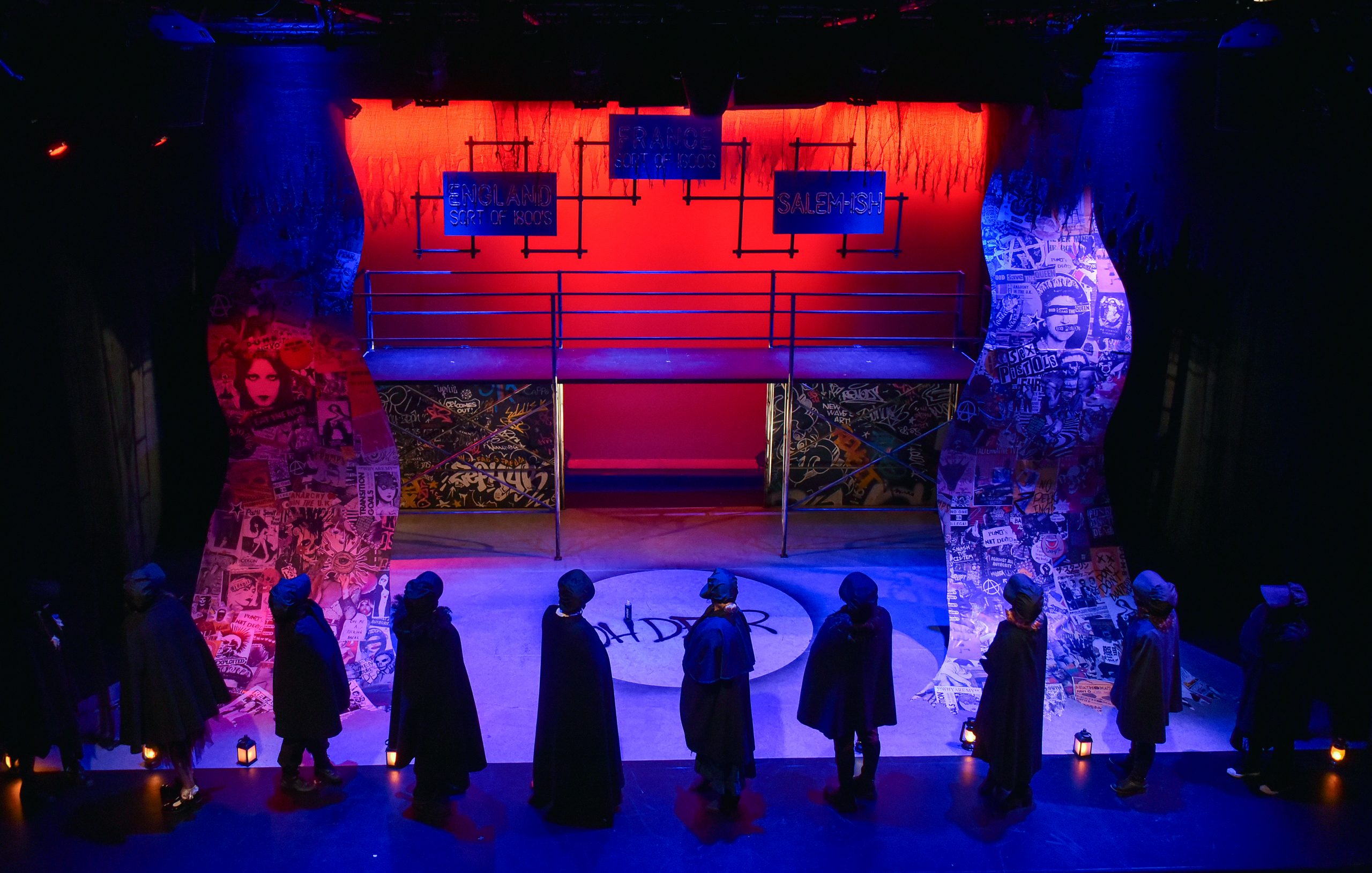FACING THE MUSIC | BONNETS Dramaturgy Note
by Hannah Freeman, Dramaturg
Bonnets: How Ladies of Good Breeding Are Induced to Murder invites you to to be transported to a world where the line between decency and depravity blurs, and where the most genteel of women discover their capacity for murder. Written by Jen Silverman in 2019, this gripping, darkly humorous, and beautifully staged production invites you to reflect on the complexities of human nature, the power of secrets, and the high price of transgressing societal boundaries.
Jen Silverman is a prolific playwright, novelist, poet, and screenwriter, who was born in Simsbury, CT, but grew up traveling in Scandinavia, Asia, Europe, and within the United States. After receiving a BA in Comparative Literature from Brown University, Silverman went on to receive an MFA from the University of Iowa in Playwriting and graduate diploma from Julliard. Their work has received numerous awards and fellowships including Yale Drama Series Award, Lilly Award, Kennedy Center’s Paula Vogel Playwriting Award, MacDowell Fellow, the Helen Merrill Fund Award in 2015, and the PoNY Fellowship (2016-2017), fellowships from the New York Foundation for the Arts and the Lower Manhattan Cultural Council. Silverman is also a 2022 National Endowment for the Arts Fellow (Prose) and 2022 Guggenheim Fellow (Theatre). Some of their other well-known works are: Collective Rage: A Play In 5 Betties; Imagine The Antarctic As A Pussy And It’s Sort Of Like That, The Moors, Phoebe in Winter, Pirates of the Cafeteria, The Roommate, Still, Wink, and Witch. In addition to their plays, Silverman has written The Island Dwellers: Stories (2018) and We Play Ourselves: A Novel (2021).
Bonnets was developed through a program known as the Big Ten Theatre Consortium. Initiated by Alan MacVey at the University of Iowa in 2014, the Big Ten Consortium took an important step toward equity in the theatrical repertoire, commissioning new plays written by female-identifying playwrights and featuring multiple strong roles for women. The purpose of starting the Big Ten Theatre Consortium was to “promote the writing and production of new works about women by professional and academic theatres around the country. It is also meant to draw attention to the need to produce and support such plays”. When the program was active, each of the schools of the Big Ten would have the first opportunity to present the newly commissioned play before becoming available for production anywhere. Five plays have been written and produced to date as a result of this initiative with the most recent and final commission to come out of the program being Jen Silverman’s Bonnets: How Ladies of Good Breeding Are Induced to Murder. The others include Good Kids, by Naomi Iizuka, Baltimore, by Kirsten Greenidge, Twilight Bowl, by Rebecca Gilman, and Companion Animals, by Madeleine George.
Bonnets masterfully combines elements of period drama: weaving through the 17th and 19th centuries, suspense, and punk rock rebellion by bringing to life a vibrant cast of characters, each ensnared in their own tangle of motivations and secrets. Looking back at how feminism has evolved through the years, the first wave of feminism in the United States took place in the late nineteenth and early twentieth centuries, emerging out of an environment of urban industrialism and liberal, socialist politics. The goal of this wave was to open up opportunities for women, with a focus on women’s suffrage. In its early stages, feminism was interrelated with the temperance and abolitionist movements and discussions about the vote, and women’s participation in politics led to an examination of the differences between men and women as they were viewed in society.
The second wave began in the 1960s and continued into the 90s. This wave emerged during a period of anti-war and civil rights movements as well as the growing self-consciousness of a variety of minority groups throughout the world. In this phase, sexuality and reproductive rights were dominant issues, and much of the movement’s energy was focused on passing the Equal Rights Amendment to the Constitution guaranteeing social equality regardless of sex. Because the second wave of feminism found voice amid so many other social movements, it was easily marginalized and viewed as less pressing than other current events. The second wave was increasingly theoretical with broader critiques of patriarchy, capitalism, normative heterosexuality, and the woman’s role as wife and mother.
The third wave of feminism began in the mid-90’s and was informed by post-colonial and post-modern thinking. In this phase, many constructs were destabilized, including the notions of “universal womanhood,” body, gender, sexuality and heteronormativity. An aspect of third wave feminism that mystified the ideals of the earlier feminist movement was the readoption by young feminists of the very lip-stick, high-heels, and cleavage proudly exposed by low cut necklines that the first two phases of the movement identified with male oppression. It permitted all users the opportunity to cross gender boundaries, and so the very notion of gender has been unbalanced in a way that encourages experimentation and creative thought.
Though fourth wave feminism is relatively difficult to define since some argue it’s simply a continuation of the third wave, while others argue an fully independent wave, the emergence of the Internet has certainly led to a new brand of social media-fueled activism. Launched by Tarana Burke in 2007, the #MeToo movement took off in 2017 in the wake of revelations about the sexual misconduct of influential film producer Harvey Weinstein. In addition to holding powerful men accountable for their actions, fourth-wave feminists are turning attention to the systems that allow such misconduct to occur.
Bonnets invites you to step into the world and atmosphere of punk. Punk rock, or ‘Punk’, is a music genre that emerged in the mid-1970s. Rooted in 1960s garage rock, punk bands rejected the perceived excesses of mainstream 1970s rock music. They typically produced short, fast-paced songs with hard-edged melodies and singing styles, stripped-down instrumentation, and often shouted political, anti-establishment lyrics. Women have made significant contributions to punk rock music and its subculture since its inception in the 1970s. In contrast to the rock music and heavy metal scenes of the 1970s, which were dominated by men, the anarchic, counter-cultural mindset of the punk scene in mid-and-late 1970s encouraged women to participate. Women have participated in the punk scene as lead singers, instrumentalists, as all-female bands, zine contributors, and fashion designers among others.
While understanding how we got to where we are today, Bonnets invites you to take a look at how women’s roles have evolved over time. The play starts with France in the 1600s, which was a time of critical change for French women. Early modern women engaged in activities ranging from food retailing to running ferry boats, but their public position took a dramatic turn for the worse after 1550. Women suffered for their powerlessness in both Catholic and Protestant lands in the late sixteenth to eighteenth centuries as changes in marriage laws restricted the freedom of wives even further, and as the differential between male and female wages increased. With Salem and the witch trials, women were subjected to even more restrictions and societal roles to play. The young girls of the town were able to play a part in accusing over 200 people of witchcraft, mostly who were women. During the Victorian period, men and women’s roles became more sharply defined than at any time in history. In earlier centuries it had been usual for women to work alongside husbands and brothers in the family business. Living ‘over the shop’ made it easy for women to help out by serving customers or keeping accounts while also attending to their domestic duties.
Set against the canvas of time, this production unveils the hidden lives of women who defy societal norms to embrace the chaotic art of murder. The fascination with murder isn’t a new idea. Between 1550 and 1700, British authors and printers produced an unprecedented number of publications that reported on capital true crimes. As literacy rates expanded and new print technologies emerged, topical leaflets began to circulate among newly literate and semi literate consumers. The types of crimes depicted in these publications will sound familiar to contemporary true crime enthusiasts: domestic or sex-related murders, women’s criminal activities, and particularly bloody assaults. Today, interest in the genre of true crime is at an all time high. From an increase in popularity of true crime podcasts, documentaries, and blogs, true crime has become intertwined in our society.
In eras – and a present – that demanded feminine decorum and obedience, these characters rise above those expectations, exploring their desires and aspirations with explosive consequences. Taking you through space and time, Bonnets will ask you to question what you know about feminism, punk, and love.
Maybe even leaving you asking, what even is the point of it all?


